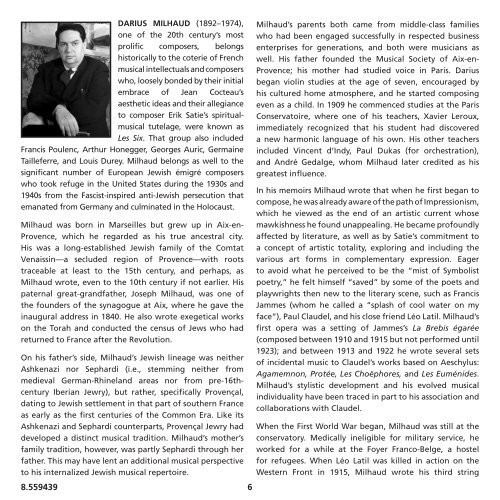Download Liner Notes PDF - Milken Archive of Jewish Music
Download Liner Notes PDF - Milken Archive of Jewish Music
Download Liner Notes PDF - Milken Archive of Jewish Music
Create successful ePaper yourself
Turn your PDF publications into a flip-book with our unique Google optimized e-Paper software.
DARIUS MILHAUD (1892–1974),one <strong>of</strong> the 20th century’s mostprolific composers, belongshistorically to the coterie <strong>of</strong> Frenchmusical intellectuals and composerswho, loosely bonded by their initialembrace <strong>of</strong> Jean Cocteau’saesthetic ideas and their allegianceto composer Erik Satie’s spiritualmusicaltutelage, were known asLes Six. That group also includedFrancis Poulenc, Arthur Honegger, Georges Auric, GermaineTailleferre, and Louis Durey. Milhaud belongs as well to thesignificant number <strong>of</strong> European <strong>Jewish</strong> émigré composerswho took refuge in the United States during the 1930s and1940s from the Fascist-inspired anti-<strong>Jewish</strong> persecution thatemanated from Germany and culminated in the Holocaust.Milhaud was born in Marseilles but grew up in Aix-en-Provence, which he regarded as his true ancestral city.His was a long-established <strong>Jewish</strong> family <strong>of</strong> the ComtatVenaissin—a secluded region <strong>of</strong> Provence—with rootstraceable at least to the 15th century, and perhaps, asMilhaud wrote, even to the 10th century if not earlier. Hispaternal great-grandfather, Joseph Milhaud, was one <strong>of</strong>the founders <strong>of</strong> the synagogue at Aix, where he gave theinaugural address in 1840. He also wrote exegetical workson the Torah and conducted the census <strong>of</strong> Jews who hadreturned to France after the Revolution.On his father’s side, Milhaud’s <strong>Jewish</strong> lineage was neitherAshkenazi nor Sephardi (i.e., stemming neither frommedieval German-Rhineland areas nor from pre-16thcenturyIberian Jewry), but rather, specifically Provençal,dating to <strong>Jewish</strong> settlement in that part <strong>of</strong> southern Franceas early as the first centuries <strong>of</strong> the Common Era. Like itsAshkenazi and Sephardi counterparts, Provençal Jewry haddeveloped a distinct musical tradition. Milhaud’s mother’sfamily tradition, however, was partly Sephardi through herfather. This may have lent an additional musical perspectiveto his internalized <strong>Jewish</strong> musical repertoire.8.559439 Milhaud’s parents both came from middle-class familieswho had been engaged successfully in respected businessenterprises for generations, and both were musicians aswell. His father founded the <strong>Music</strong>al Society <strong>of</strong> Aix-en-Provence; his mother had studied voice in Paris. Dariusbegan violin studies at the age <strong>of</strong> seven, encouraged byhis cultured home atmosphere, and he started composingeven as a child. In 1909 he commenced studies at the ParisConservatoire, where one <strong>of</strong> his teachers, Xavier Leroux,immediately recognized that his student had discovereda new harmonic language <strong>of</strong> his own. His other teachersincluded Vincent d’Indy, Paul Dukas (for orchestration),and André Gedalge, whom Milhaud later credited as hisgreatest influence.In his memoirs Milhaud wrote that when he first began tocompose, he was already aware <strong>of</strong> the path <strong>of</strong> Impressionism,which he viewed as the end <strong>of</strong> an artistic current whosemawkishness he found unappealing. He became pr<strong>of</strong>oundlyaffected by literature, as well as by Satie’s commitment toa concept <strong>of</strong> artistic totality, exploring and including thevarious art forms in complementary expression. Eagerto avoid what he perceived to be the “mist <strong>of</strong> Symbolistpoetry,” he felt himself “saved” by some <strong>of</strong> the poets andplaywrights then new to the literary scene, such as FrancisJammes (whom he called a “splash <strong>of</strong> cool water on myface”), Paul Claudel, and his close friend Léo Latil. Milhaud’sfirst opera was a setting <strong>of</strong> Jammes’s La Brebis égarée(composed between 1910 and 1915 but not performed until1923); and between 1913 and 1922 he wrote several sets<strong>of</strong> incidental music to Claudel’s works based on Aeschylus:Agamemnon, Protée, Les Choëphores, and Les Euménides.Milhaud’s stylistic development and his evolved musicalindividuality have been traced in part to his association andcollaborations with Claudel.When the First World War began, Milhaud was still at theconservatory. Medically ineligible for military service, heworked for a while at the Foyer Franco-Belge, a hostelfor refugees. When Léo Latil was killed in action on theWestern Front in 1915, Milhaud wrote his third string
















